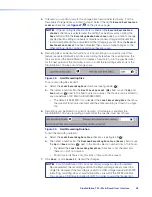
StudioStation 100 • Web-Based User Interface
43
•
Configure output stream settings and presets.
•
Set up AV encoding and metadata.
•
Set passwords.
•
Set up notices and alarms.
•
Configure basic communication, identity, time, data storage, and recording location
settings.
•
Upgrade the unit by updating firmware.
•
Save configurations or restore a configuration from a saved file.
Configuration Tab Features
The pages within
Configuration
on the previous
page):
Input/Output Settings
— Provides a way to change the name for the input, select
the video format, select an aspect ratio type, and enable or disable Auto-Image, Auto
Memory, and HDCP authorization. This page includes audio configuration to adjust
audio levels. It also allows you to output one of several video test patterns for use
during display setup, select the refresh rate for the local HDMI output, and configure the
universal OSD content (see
EDID
— Provides a way to choose the resolution and refresh rate for the HDMI input,
from a selection of common settings, as well as configure your own custom EDID (see
Image
Settings
— Provides a way to configure video input sampling and sizing, set up
overscanning of SMPTE input signals, and adjust picture controls (brightness, contrast,
and the like). It also allows you to save or recall input presets (see
page 49).
Encoding
&
Metadata
The first expandable panel in this page makes it possible to:
•
Set up AV encoding.
•
Configure the streaming method, protocol, and settings.
•
Create encoder and streaming presets.
The second panel contains controls that make it possible to do the following:
•
Select fonts for metadata information.
•
Create recording profiles.
•
Configure metadata elements.
Users
and
Roles
— Provides a way to set administrator and user passwords (see
Alarms
and
Traps
— Provides a way to set up the e-mail server and the sender and
recipient e-mail addresses for notifications. Select the alarm "severity" level for each of
several types of errors or conditions monitored by the unit (see
page 55).
System
Settings
— Contains an assortment of settings in ten expandable panels. An
administrator can configure settings for unit identity (unit name and network location),
network and serial communication, storage, date and time, and the like. Also, update
firmware, and save configurations or restore a configuration from a saved file (see
Advanced
Features
— Enables a Web browser client option on the unit or to upload
new applications (see






























